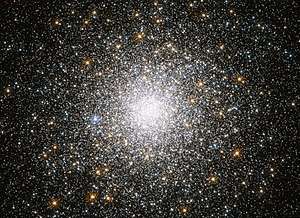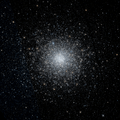Messier 75
Messier 75 or M75, also known as NGC 6864, is a globular cluster of stars in the southern constellation Sagittarius. It was discovered by Pierre Méchain in 1780 and included in Charles Messier's catalog of comet-like objects that same year.[7]
| Messier 75 | |
|---|---|
 | |
| Observation data (J2000 epoch) | |
| Class | I[1] |
| Constellation | Sagittarius |
| Right ascension | 20h 06m 04.85s[2] |
| Declination | −21° 55′ 17.85″[2] |
| Distance | 68 kly (20.9 kpc)[3] |
| Apparent magnitude (V) | +9.18[4] |
| Apparent dimensions (V) | 6.8′ |
| Physical characteristics | |
| Absolute magnitude | −8.57[2] |
| Radius | 67 ly[5] |
| Tidal radius | 5.7′[3] |
| Metallicity | = −1.29[6] dex |
| Other designations | GCl 116, M75, NGC 6864[4] |
M75 is at a distance of about 67,500[3] light years away from Earth and is 14,700[6] light years away from, and on the opposite side of, the Galactic Center.[8] Its apparent size on the sky translates to a true radius of some 67 light years.[5] M75 is classified as class I, meaning it is one of the more densely concentrated globular clusters known. It shows a slow rotation around an axis that is inclined along a position angle of −15°±30°.[3] The absolute magnitude of M75 is about −8.5 or some 180,000 times more luminous than the Sun.[7]
The cluster has a half-light radius of 9.1 ly (2.80 pc)[6] with a core radius of about 1.6 ly (0.5 pc) and appears not to have undergone core collapse yet. The mass density at the core is 7.9×104 M☉·pc−3.[2] There are 38 RR Lyrae variable stars and the cluster appears to be Oosterhoff-intermediate in terms of metallicity.[8] 62 candidate blue stragglers have been identified in the cluster field, with 60% being in the core region.[2]
Messier 75 is part of the Gaia Sausage, the hypothesized remains of a dwarf galaxy that merged with the Milky Way.[9] It is a halo object with an orbital period of 0.4 Gyr around the galaxy and a large eccentricity of 0.87. The apocenter is 57 kly (17.5 kpc) – close to the current separation.[3]
Gallery
 Messier 75 color rendering by Aladin-software.
Messier 75 color rendering by Aladin-software. Map showing location of M75
Map showing location of M75
References
- Shapley, Harlow; Sawyer, Helen B. (August 1927), "A Classification of Globular Clusters", Harvard College Observatory Bulletin, 849 (849): 11–14, Bibcode:1927BHarO.849...11S.
- Contreras Ramos, R.; et al. (April 2012), "The Unimodal Distribution of Blue Straggler Stars in M75 (NGC 6864)", The Astrophysical Journal, 748 (2): 9, arXiv:1201.4959, Bibcode:2012ApJ...748...91C, doi:10.1088/0004-637X/748/2/91, 91.
- Koch, Andreas; et al. (August 2018), "Kinematics of outer halo globular clusters: M 75 and NGC 6426", Astronomy & Astrophysics, 616: 9, arXiv:1805.06894, Bibcode:2018A&A...616A..74K, doi:10.1051/0004-6361/201833110, A74.
- "NGC 6864". SIMBAD. Centre de données astronomiques de Strasbourg. Retrieved 16 November 2006.
- From trigonometry: radius = distance × sin( diameter_angle / 2 ) = 67 ly.
- van den Bergh, Sidney (February 2012), "Sizes of Galactic Globular Clusters", The Astrophysical Journal, 746 (2): 4, arXiv:1201.3597, Bibcode:2012ApJ...746..189V, doi:10.1088/0004-637X/746/2/189, 189.
- Frommert, Hartmut; Kronberg, Christine (2 September 2007), "Messier 75", SEDS Messier pages, Students for the Exploration and Development of Space (SEDS), retrieved 5 December 2018.
- Corwin, T. M.; et al. (May 2003), "M75, A Globular Cluster with a Trimodal Horizontal Branch. II. BV photometry of the RR Lyrae Variables", The Astronomical Journal, 125 (5): 2543–2558, arXiv:astro-ph/0301542, Bibcode:2003AJ....125.2543C, doi:10.1086/374232.
- C., Myeong, G.; et al. (August 2018), "The Sausage Globular Clusters", The Astrophysical Journal Letters, 863 (2): 5, arXiv:1805.00453, Bibcode:2018ApJ...863L..28M, doi:10.3847/2041-8213/aad7f7, L28.
External links
| Wikimedia Commons has media related to Messier 75. |
- Messier 75, Galactic Globular Clusters Database page
- Garner, Rob, ed. (16 March 2018), Messier 75, NASA, retrieved 5 December 2018.
- Messier 75 on WikiSky: DSS2, SDSS, GALEX, IRAS, Hydrogen α, X-Ray, Astrophoto, Sky Map, Articles and images
